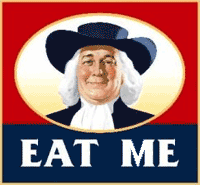American cuisine
Cuisine in the United States often baffles people who have the bad fortune to live "outside the country" and believe there is simply no way to apply the signature American traits of obsessive excess, horrible aesthetics, and inscrutable regional variation, to a topic as simple and natural as food. But American ingenuity triumphs again, resulting in a cuisine that shows each of those character disorders. Worst of all, the portions are huge and meals are annoyingly inexpensive.
Foreign foods (of other countries)
Fundamentally, America is not the best country – it is all the countries. Every city large enough to have either two "strips" or one downtown will have several restaurants serving the food of every continent of the world. Immigrants run these restaurants (until their children find out how much easier it is to claim Permanent Disability) and serve foods from the "old country", deep-fried in a special oil that removes all flavor. Greeks, for example, flout the Fire Marshal and bring cheese to the table with flaming ouzo that singes the ceiling tiles.
Foreign foods brought to America lose something in the translation. We all know that pizza is available nowhere in Italy, only at American chain restaurants with tacky plywood "leaning towers". Only on arriving in American did Cambodian chefs acquire the freedom to invite their diners to try the Pol Pot Pie. Taco Bell is an example of Mexican food served everywhere in the U.S. (and nowhere in Mexico except, lately, Taco Bells). Mexican Taco Bells exclusively serve tourists from the U.S. who blame their first bout of Montezuma's Revenge on that charming hole-in-the-wall food stand with uncovered sauce bowls, and will want something safer for the rest of their week abroad.
Being all the countries, the United States has all the tastes in food. That is why all its really big food operators choose one style exactly in the middle. The Mexican brewers of Dos Equis and Bohemia enjoyed a faithful but minuscule following in the United States, until wisely groping for that big round thing hanging in the middle of the Bell Curve and getting rid of the odd, earthy taste. Their products are selling better now, among Americans who want to drink a Mexican beer because of what it means about them – and have no clue what it would mean about the beer.
This is how American cuisine acquired its signature description: bland.
History
Fad food
The first great food fad was in the late 1940s. American soldiers were returning home from World War II, the vast American productive engine was looking for things to manufacture now that bombers were no longer selling well, and the idea occurred that food could be assembled in the bomber plants, rather than grown on the farm. Products rolled off the assembly line, from Spam to Cheez Whiz. (Australia made a valiant effort with Vegemite, but it did, after all, lose the war.)
This historic trend was another reason American food is bland.
The fad, however, produced a backlash. New generations always seem to rebel against their parents, and the "baby boom" born after the war developed a strange desire for food that could be tasted. Although this generation is best known for hedonism and free sex, as it matured, its members demanded micro-breweries and strange varieties of lettuce that don't crunch.
Even later, the backlash produced a backlash, as the next generation again sought the security of blandness. McDonald's would cater to this generation with a new milkshake that famously had no natural ingredients at all. It is just as well, because their parents in the libertarian "baby boom" generation saddled the country with an unprecedented amount of dietary nagging, and we can no longer add enough salt to taste our food even if we wanted to.
Fast food
Having devised a new food, the American entrepreneur naturally seeks a way for all 310,000,000 Americans to eat it at the same time. (This is what President Obama no doubt means by "universal coverage".) The entrepreneur turns to franchising, in which complete strangers receive a Policy Manual that tells how to repeat the entrepreneur's success, a contract providing for hefty monthly payments including a percentage of the profit, and legal documents ensuring that, if success doesn't ensue, they can't sue the founder.
The chain tries to deliver the customer a totally predictable experience from outlet to outlet. So franchises in New Orleans can't serve Cajun until the home office in Chicago develops a recipe and test-markets it in Juneau. Likewise, selling some of that fresh-baked bread without first assembling one of the four sandwiches on the menu board is a threat to the entire enterprise, though the customer of Subway can always get the same result by simply buying a sandwich and discarding the fillings.
More food
No sooner do Americans put a restaurant wherever you are, than the goal becomes to have several restaurants there. Individual restaurants are giving way to the food court in shopping malls, ballparks, and next year, on the International Space Station. Different family members can eat at different restaurants, but sit together; and they can even have different courses at different restaurants. The latter process is known as grazing, and with none of the bovine implications, until one gets a look at the resulting herd.
Culinary imperialism
Achieving universal cuisine coverage for all 310,000,000 Americans would still leave about seven billion souls (and more relevant, gullets) potentially unable to order their daily McFritters. The entrepreneur addresses this problem through foreign franchises. It is often more difficult to wring cash out of foreign franchises, to bridge language and culture barriers, and to enjoy total impunity from lawsuit when not even the Dollar Menu does a good business in Ethiopia. Nevertheless, the rest of the world's hunger for anything American is exceeded only by Americans' hunger for anything that isn't. This is why Americans operate restaurants in Mexico that use letters not in the national language's alphabet, and others that claim to serve the locals' food, such as nachos, that is completely foreign to them.
Nestlé led the way with powdered baby formula. Ever since, American attempts to provide cheap, safe, and predictable food, and to free people to spend 60 hours on the job as Americans do, have been met by unanimous resistance by everyone from professional anti-business gadflies, to Culture Ministers who actually happen to live in the affected country. Now, "cultural imperialism" is a loose use of the language, like "statutory rape" or "implied consent". But people in the Old World have always taken four hours for lunch (if you count the sex and the nap afterward), and an establishment at which your meal was ready two hours before you arrived is profoundly threatening to them.
Specific innovations
Adding cheese to a cheese dish
America invented the three-cheese quesadilla, the four-cheese pizza, the seven-cheese quiche, and recently the twelve-cheese embolism (a notorious example of food "going down the wrong pipe"). In retrospect, it was obvious that Americans, endeavoring to improve on a traditional cheese dish, would stumble upon, then leap into, the idea of simply using even more cheese. Usually, they add different varieties of cheeses to impart additional flavors. However, Americans are equally happy with quantity as quality, and may simply dump in a triple helping of the same cheese (pictured).
Americans proudly refer to these confections as "meals that fight back", and their prevalence may explain television's obsession with digestive aids, as well as the attention paid to the water used by flushing the toilet.
Comfort food
Tourists from outside the U.S. who visit a ballpark and think they are on a whale watch understand the cumulative effect of American cuisine. But it is also a staple of Americana that any personal indiscipline (even when exhibited by white heterosexuals in the country legally) constitutes a duty of everyone else to improve their tolerance. Organizations like the Fat Acceptance League (motto: Get Used to It) ensure that people who need you to vacate the supermarket aisle or step into the street so they can pass are not met with hurtful ridicule.
In this frame of mind, American dishes whose main ingredient is lard are no longer referred to as "fatty" – indeed, no one is – but as "comfort food". It does not matter that you are having trouble getting that next spoonful down, as you watch me with my trowel; all that matters is that I am deriving comfort. The reader will recognize this as classic American salesmanship. Indeed, its inventor is now earning top dollar trying to move Chevy Volts off the lot before they catch fire.
Fear of food
In this game, American science identifies something harmful in high doses (high doses, again, being the only constant in American cuisine) – for example, saturated fat. American industry invents a healthier alternative; in this case, named trans-fat, as it employs the same technology that will soon give us the trans-warp space drive. Then American gadflies find that it isn't perfect. Most people who eat trans-fat go on to develop grey hair and sometimes wrinkles. (Deal with it, conservatives; that's a fact.) Politicians such as Al Franken treat it as a national crisis. At this stage, of course, it becomes known as a "Frankenfood".
The solution is to pump double the saturated fats back into the product and devise a brand new label shouting that the product is FREE of trans-fats. A recommendation from a doctors' guild and a cartoon mascot complete the product's rehabilitation and the consumer feels he is eating healthy, and perhaps Saving the Planet.
Another food scare consists of contamination of our foods. Fox News loves this more than scary weather, airport evacuations, and gunplay at grade schools. The government shuts down a company or an entire industry, "just to be safe", while it searches for the source of the contamination, usually Mexican farmworkers with bad hygiene. But the Hunt for Brown Arugula never costs anyone anything, as is shown by our consistently low inflation (when we use the statistic that pretends we don't have to eat or drive). Couldn't everyone just wash the lettuce and cook the hamburger before scarfing it down? Of course not; America is a consumer-oriented society, and besides, you can't engage in the Pursuit of Happiness if you're getting your stomach pumped.
The most recent Franken Food is the Genetically Modified Organism or GMO. GMOs happen when humans do with microscopes what humans have been doing with Dumb Luck for centuries: try to breed a cow that will give more milk. It does not calm the fears when they dispense with GMO cows and just feed GMO grain to normal cows; nor when a decade passes without anyone being able to detect anything different in the milk itself. GMOs are directly causal of:
- more hearings before Senator Franken, and
- hundreds of hippies chanting slogans about greed at Purina Corporate Headquarters. (Dozens of hippies protested GMOs at GM Headquarters instead, but any population has its slow learners.)
Both activities give one a powerful hunger. Therefore, the development of GMO has been a boon for the American food chain.
Guilt over food
Completing the trend that started with the backlash, then the backlash against the backlash, was the backlash about all the backlashes. Michael Moore wrote a record-setting, blame-American-cuisine-first documentary exposing the national diet and its effect on the national waistlines. This was his Best-of-Cannes feature, I'll Have One of Each, and It's Your Fault. It may explain his choice of topics that Moore is a native of Flint, Michigan, itself in a state that boasts the couch potato as the state vegetable.
Government to the rescue
The backlash to that backlash movie was more universal coverage, as all food now has a Nutrition Facts label. Industry is not forced to do whatever I say, only to tell you what I want you to know, which doesn't cost anyone anything.
Unfortunately, much as any businessman can report a profit for a single quarter, any food can make a single health claim. That is why candy is labeled "fat-free", various ice creams are "sugar-free", everything in America is now free of trans fat, and everything has twice the additives of a decade ago to put the taste back in so people will still buy it.
Nutrition labels demonstrate that open-government reforms are co-opted before the ink is dry. Labels give minuscule serving sizes devised after Nurse Ratched testified before Congress. If there's less than half a gram per thimble-full, the makers round down and claim There Isn't Any. And to make a food "fat-free", just get rid of the triglycerides and pump in the mono- and di- equivalents. Easy as spaghetti!
The Acme of this trend (and solely in the Wile E. Coyote sense) is the term "multi-grain". This guarantees that the product is loaded with fat and sugar and salt, but promises there will be no unpleasantness in the bathroom tomorrow. So you know you're eating healthy.
Impossibile foods
Americans are renowned at innovation and not just lying. But innovation constantly struggles with vested interests and their lobbyists. (Lying does not; that would be like engaging in a tug-of-war against yourself.)
Margarine was America's first, halting step toward high-tech alternatives to food. Laws quickly emerged to force all store-bought margarine to be colored blue (the color of all truly fine molds), to require mixing by the customer, and to be extruded from a live cow (this last, in the interest of "a level playing field").
Sugar-free sugar has been available in America since the 1970s under various brand names from saccharine to succubus. The first application was in soda pop. "Tab" was a revolutionary product which gained universal approval so quickly that government had to step in to require an unpleasant "metallic" after-taste, usually achieved by adding aluminum shavings (or, as it's now known, "fiber"). Tab is now sold primarily on eBay, alongside Seventies Porn.
In 1996, the government approved the use of fat-free fat. Although "Olestra" was a product of research at Procter & Gamble into a more perfect paint thinner, acceptance as a cooking ingredient was immediate. Regulators dealt with objections from manufacturers of fat-based fat by insisting on labeling employing descriptions of abdominal pain written by Stephen King, and of bowel movements written by Larry Flynt, but these requirements were waived after several years when Pringles submitted proof that no one really ate the stuff.
One complaint voiced by regulators was that Olestra tasted so realistic consumers would feel free to splurge at other meals, the way seat belts make drivers feel free to swerve and cut in line. This is an inherent problem with diet foods devised by corporate America, and yet another fine basis for a lawsuit. (When diets are enforced for two hours a day by New York City "mayor" Michael Bloomberg, First "Lady" Michelle Obama, or the mean woman who runs the grade-school cafeteria, there are no such concerns.)
Scientists at DuPont are researching a totally food-free food. This revolutionary substance will have zero trans-fats, zero calories, and zero taste. Consumers who cannot wait for the completion of the engineering and the years of regulatory deliberations may instead eat Styrofoam packing material, which after all, has the appetizing name "popcorn". It's great with gravy and mayonnaise.






